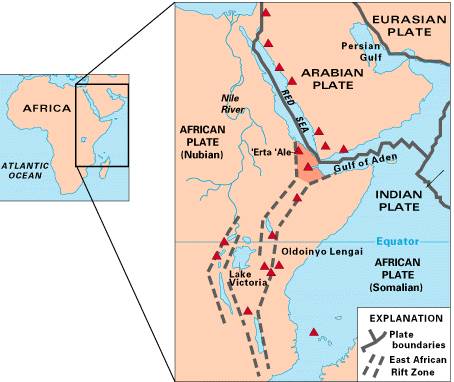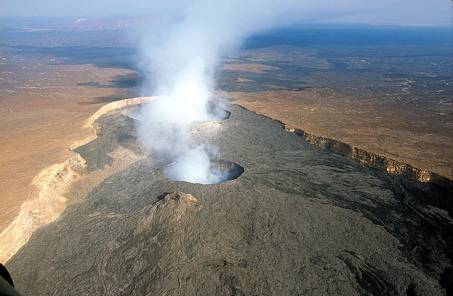Afar Depression
The Jebel Qatrani
Online Biology Dictionary
The permanent lava lake at Erta Ale, Afar Depression|
|
EUGENE M. MCCARTHY, PHD
 The Afar Depression (shaded and at center in the map above) is a triple junction, where three plates are pulling away from each another: the Arabian Plate, and the two parts of the African
Plate (the Nubian and the Somalian) splitting along the East African Rift Zone. The Afar contains Ethiopia’s Middle Awash. The region adjacent to this river has yielded numerous important hominid finds.
The Afar Depression (shaded and at center in the map above) is a triple junction, where three plates are pulling away from each another: the Arabian Plate, and the two parts of the African
Plate (the Nubian and the Somalian) splitting along the East African Rift Zone. The Afar contains Ethiopia’s Middle Awash. The region adjacent to this river has yielded numerous important hominid finds.
 The volcano Erta Ale lies in the desert region of the Afar. The most active volcano in Ethiopia, it’s topped by a permanent lake of lava, one of only four volcanoes worldwide with this feature.
The volcano Erta Ale lies in the desert region of the Afar. The most active volcano in Ethiopia, it’s topped by a permanent lake of lava, one of only four volcanoes worldwide with this feature.
The Afar Depression (also called the Danakil Depression or the Afar Triangle) is a geological depression formed by the junction of the East African Rift with the two spreading ridges that have formed the Red Sea and the Gulf of Aden. It lies near the Horn of Africa, overlapping Eritrea, Djibouti, and the Afar Region of Ethiopia.
In the depression, along each of the three rifts, the Earth’s crust is spreading apart at an annual rate of about 0.3-0.8 inches (1-2 centimeters). There are many deep fissures in the ground and small earthquakes occur in this region on an almost continuous basis. It’s one of two places on Earth where a spreading ridge, such as those normally found in the middle of the world’s oceans, can be studied on land (the other being Iceland).
The Afar contains the Middle Awash Valley, a region that has yielded many fossil hominid discoveries (in particular, Ardipithecus ramidus, Ardipithecus kadabba, and Australopithecus garhi); the Kada Gona river valley, site of discovery of the oldest stone tools known, which date to about 2.5 mya (Semaw et al. 1997, Semaw 2000); and Hadar, where Lucy, the best-known specimen of Australopithecus afarensis was found.
Some of the surreal scenery of the Afar:
Most shared on Macroevolution.net:
Human Origins: Are we hybrids?
On the Origins of New Forms of Life
Mammalian Hybrids
Cat-rabbit Hybrids: Fact or fiction?
Famous Biologists
Dog-cow Hybrids
Prothero: A Rebuttal
Branches of Biology
Dog-fox Hybrids